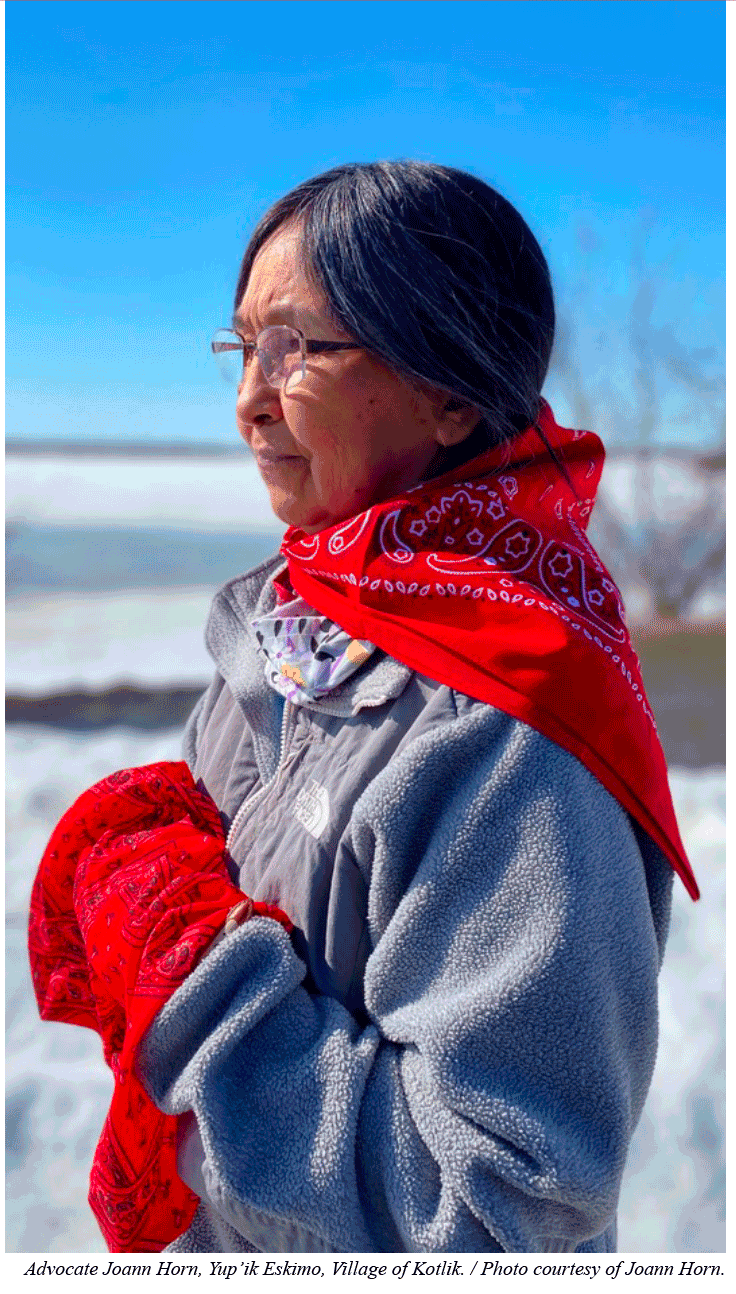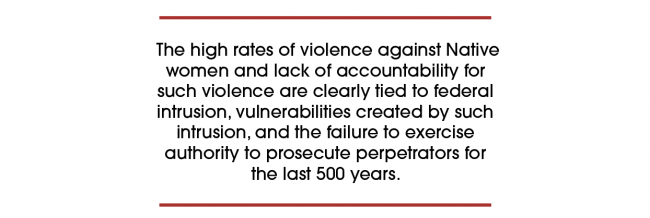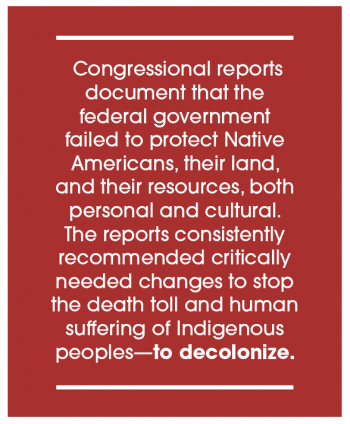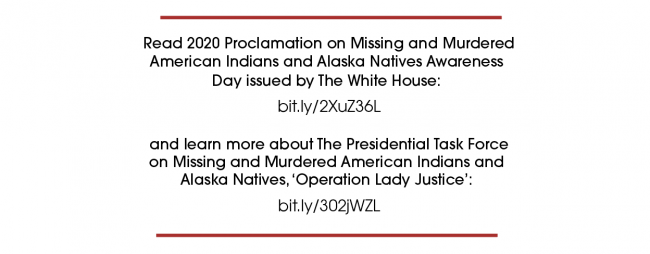
MMIW: Understanding the Missing and Murdered Indigenous Women Crisis Beyond Individual Acts of Violence

A Statement Prepared by NIWRC Policy Team Members Jacqueline Agtuca, Elizabeth Carr, Brenda Hill, Paula Julian, and Rose Quilt
From the beginning of European contact, Indian nations as sovereigns, engaged with foreign countries as governments. As sovereigns, Indian nations held full authority over the lands and peoples within their respective territories. The diminishment of this authority to a position of dependent nations within the United States occurred as a result of U.S. colonization.
The quality of life of the citizens of any nation is bound to the authority and resources of their respective governments to create stable and safe communities.
In the specific context of Native women, the original protections and concept of safety has deteriorated over five centuries of U.S. colonial Indian law and policies reflected in the current spectrum of violence and the crisis of missing and murdered Indigenous women (MMIW). In general, addressing the MMIW crisis requires reforms to the foundational set of laws and policies, creating the social conditions for the violence to reach the depth and breadth we see at present.
“Bad people commit these horrible crimes against Native women, but it is the system that allows it to happen generation after generation.”—Malinda Limberhand, mother of Hanna Harris who was murdered in 2013 on the Northern Cheyenne Reservation.
A person’s relationship to a problem often reflects their framework or worldview for understanding it. While violence against Native women is committed by individuals—abusers, rapists, traffickers—it is federal colonial policies and laws that created the social setting for such crimes. While living in the same country the worldview of the colonized versus that of the colonizer are fundamentally distinct.
Understanding the impact of U.S. colonization on Native women is essential to creating the necessary reforms to address the MMIW crisis because current federal law is based upon the laws and policies of earlier eras of U.S. colonization and continue to govern.
The essential reforms required to address violence against Native women are more complicated than increased training and resources under federal reforms such as VAWA. To address violence against Native women at a foundational level requires a deep dive to understand and repeal or amend previous colonial-era laws.
The underlying legal foundations of U.S. federal Indian policies while outdated continue to undermine tribal protections preventing Indian Nations from the full authority to protect Native women.
Legal Foundation of Violence Against Native Women and Genocide
Colonialism has many definitions but generally is defined as an act of one nation controlling another for economic gain. “In 1945, some 750 million people lived in territories that were dependent on colonial powers. Today, fewer than 2 million people live under colonial rule in the 17 remaining non-self-governing territories. The wave of decolonization, which changed the face of the planet, was born with the United Nations and represents the world body’s first great success.” The exercise of foreign control of one government over another was generally by force and violence.
The horrors of colonization of Indigenous nations is not specific to the United States. What separates U.S. colonization from that of other colonizers is the failure to understand and reconcile colonial laws and practices toward Indian nations, specifically federal laws limiting Tribal protections of women.
The current control of the U.S. government over Indian Nations is tied to the earlier era of colonization by European monarchs, and later the European Nations that emerged. These monarchs, queens and kings, some with a religious decree, claimed Indigenous lands based on their individual rights as monarchs and some as god’s representative on earth. This claim, known as the Doctrine of Discovery, created a spiritual, political, and legal justification for seizure of lands inhabited by non-Christians. These claims to Indigenous lands lacked the consent of Indigenous Nations and used violence to gain control and convert the colonized to Christianity.
The formation of the United States occurred in the context of international diplomacy and balancing trade and commerce with Indian Nations with the need for alliances against England during the revolutionary war. The view of Indian tribes as full sovereigns in the context of regulating trade was provided for in the U.S. Constitution in 1787. Legislation passed during the first Congress asserted control over Indian affairs solely under the national government, not the states. The authority to govern—safeguard the lives of women from Indian and non-Indians—within their territories rested exclusively with Indian nations.
From International Diplomacy to Colonialism
The shift from international diplomacy to federal colonialism undermined the right of Indian Nations to self-government and the authority to protect Native women. Current federal Indian law is often referred to as a maze of injustice. It lacks logic and a moral standard because it was created based on the drive of the United States to lay stake to Tribal lands and resources.
In 1817, Congress passed the first statute creating federal jurisdiction over individual Indians in Tribal territory who committed serious crimes against non-Indians. Today, this statute is the basis of the General Crimes Act. It was followed by the enactment of the Major Crimes Act in 1885, providing federal jurisdiction over seven major crimes committed by Indians against the person or property of Indians or others on an Indian reservation. The seven crimes were expanded over the years to the current sixteen crimes, most of which are recognized as common to the pattern of domestic violence. Unfortunately, these two statutes from 1817 and 1885 continue as cornerstones of current federal Indian law.
In the context of addressing violence against Native women and specifically cases of MMIW, federal intrusion into the authority of Indian Nations has resulted in perpetrators of crimes facing little, if any, consequences for their actions, including government employees and those charged with responsibilities for federal programs such as boarding schools and healthcare services.

A third federal intrusion into the criminal authority of Indian Tribes was enacted as part of the Termination Era toward Indian Nations through the transfer of federal authority to state governments under Public Law 280. While passed based on the argument that it would address lawlessness through the handling of criminal cases by the state government it further deprived Native women of access to justice services.
The interpretation of federal criminal statutes further complicated the authority of Indian Nations to hold abusers accountable. Until the implementation of the 2005 Violence Against Women Act the common misinterpretation of the Major Crimes Act was that it divested tribes of authority of over the enumerated crimes. The same federal colonial framework also led to the misinterpretation of Public Law 280 as creating sole criminal jurisdiction in the state governments over crimes committed within tribal jurisdiction. Under Attorney General Janet Reno the USDOJ clarified that Indian tribes retained concurrent jurisdiction over crimes, such as rape, under both statutes. For decades Indian Nations did not prosecute sexual assault and other cases because of this misinterpretation.
The USDOJ statistic of 1 of 3 Native women will be raped in her lifetime is just one example of the consequences of the colonial framework denying Indian Nations the authority to protect women. This consistent shift away from the view of international diplomacy found in the Constitution to one of colonial federalism continues to be devastating in the lack of real and perceived protections for Native women.
Federal Colonialism: Denial of Authority and Resources
As affirmed in the 2009 Apology to Native Peoples, the U.S. recognized that there have been years of official depredations, ill-conceived policies, and the breaking of covenants by the Federal Government regarding Indian tribes; and apologized for the many instances of violence, maltreatment, and neglect inflicted on Native Peoples.
Congressional reports throughout history document the failure of federal policies and recommended changes needed to correct failed colonial approaches. The 1867 Doolittle Report tracing a large majority of Indian Wars to lawless white men. The 1928 Problem of Indian Administration Report criticizing the Department of Interior’s (DOI) implementation of the Dawes Act and overall conditions on reservations and in Indian boarding schools. The 2003 report, A Quiet Crisis, Federal Funding and Unmet Needs in Indian Country, documented unconscionable federal funding levels for Indian tribes and resulting living conditions. The 2013 Indian Law and Order Commission Report, A Roadmap For Making Native America Safer, similarly criticized federal restrictions and recommended restoring tribal sovereignty. Most recently, the release in 2018 of the U.S. Commission on Civil Rights Broken Promises Report continues to affirm the need for the United States to fulfill its trust responsibility with appropriate allocation of resources.
These and other congressional reports document that the federal government failed to protect Native Americans, their land, and their resources, both personal and cultural. The reports consistently recommended critically needed changes to stop the death toll and human suffering of Indigenous peoples—to decolonize. While occurring over several centuries these reports reflect the failure of the federal colonial approach to tribal governance, and also document the potential strength, if unleashed, of Indian Nation to address the needs of Tribal citizens.
The high rates of violence against Native women and lack of accountability for such violence are clearly tied to federal intrusion, vulnerabilities created by such intrusion, and the failure to exercise authority to prosecute perpetrators for the last 500 years. Today, this pattern continues and is reflected in the lack of accountability of perpetrators documented in the minimal prosecutions and federal declinations by United States Attorneys of domestic violence, sexual assault, and trafficking cases.
The 2013 report to Congress by the Indian Law and Order Commission, is one of the most comprehensive assessments ever done of criminal justice systems servicing Native American and Alaska Native Communities. In its report the Commission summarized federal Indian law.
 “The Commission has concluded that criminal jurisdiction in Indian country is an indefensible morass of complex, conflicting, and illogical commands, layered in over decades via congressional policies and court decisions and without the consent of Tribal nations.” The multiple layers of Congressional Acts, Presidential Orders, and Supreme Court rulings have, through the course of history, giving legal color to what the United Nations defines as genocide. In 1946 the
“The Commission has concluded that criminal jurisdiction in Indian country is an indefensible morass of complex, conflicting, and illogical commands, layered in over decades via congressional policies and court decisions and without the consent of Tribal nations.” The multiple layers of Congressional Acts, Presidential Orders, and Supreme Court rulings have, through the course of history, giving legal color to what the United Nations defines as genocide. In 1946 the
United Nations General Assembly recognized genocide as a crime prohibited under international law. The crime of genocide is defined as “any of the following acts committed with intent to destroy, in whole or in part, a national, ethnical, racial or religious group, as such: a. Killing members of the group; b. Causing serious bodily or mental harm to members of the group; c. Deliberately inflicting on the group conditions of life calculated to bring about its physical destruction in whole or in part; d. Imposing measures intended to prevent births within the group; e. Forcibly transferring children of the group to another group.”
While the UN recognition of the crime of genocide did not occur until 1947, the eras of the Indian Wars, removal, boarding schools, termination, forced sterilization, and other federal laws and policies were developed with the intentional destruction of Indian Nations by the United States. Today these past U.S. laws and policies continue to dehumanize Indigenous peoples, specifically women, and support the legal and cultural infrastructure underlying the crisis of MMIW.
“A great general has said that the only good Indian is a dead one, and that high sanction of his destruction has been an enormous factor in promoting Indian massacres. In this sense, I agree with the sentiment, but only in this: that all the Indian there is in the race should be dead. Kill the Indian in him, and save the man.”
Reconciliation of the United States with Indian Nations
Colonization of the Indigenous Peoples of the world was not isolated to the United States. During the same era, the Canadian government enacted similar laws and policies towards Aboriginal peoples, such as its boarding school era. Canada’s National Inquiry into Missing and Murdered Indigenous Women and Girls is one example of a political process to analyze for lessons. One area of particular interest is the concentration of the reconciliation process on government accountability for the murders of Indigenous women and girls. The report from the Inquiry released in May of 2019 said: “Genocide is the sum of the social practices, assumptions, and actions detailed within this report.” The Inquiry held 24 hearings across Canada, and at least 2,380 people attended, including the families of those killed or missing. While not complete or a perfect process, it is one far in advance of the United States.
Due to the national movement, the United States has taken some steps to reform colonial-era law and policies to strengthen Indian Nations in their protection of Native women. Since 1995 following the passage of the Violence Against Women Act, Indian tribes amplified their collective voices to make strong recommendations to government officials. The mandate under the Tribal Title of VAWA 2005 provided for annual consultation between Indian Nations and specific federal departments. Since the first consultation in 2006, Tribal leaders consistently reiterated that to address violence against Native women, full Tribal sovereignty must be restored with adequate resources to implement such authority to fully protect women.
The 2020 annual consultation once again provides an essential opportunity to engage on the scope of reforms needed to address the crisis of MMIW.
The United States, in the context of a federal colonial framework, justified laws diminishing the tribal protections provided Native women. Implementation of these laws and policies regarding Indian affairs created the social context for the normalization and acceptance of violence against Native women. The United States has the authority and the resources to end the crisis of violence against Native women but has not demonstrated the will.
Legislation introduced in 2019, provided Congress the opportunity to strengthen the authority of Indian nations to protect women, including essential resources, to implement expanded protections. This legislation included reauthorization of the Violence Against Women Act and the Family Violence Prevention Services Act, and amending the Victims of Crime Act. To specifically address the MMIW crisis, five bills were introduced in the House and Senate; the President issued a National Day of Awareness MMIW proclamation and created the “Operation Lady Justice Initiative,” and the Senate passed the National Day of Awareness Proclamation.
Congress failed to pass any of the 2019 legislative reforms drafted in cooperation with tribal leaders and advocates.
The crisis of MMIW is a national crime pattern. The complete storyboard for this crime pattern is not two individuals and a crime scene but all of the above--the government, culture, and economics--layered upon the lives of Native women and Indian nations. Understanding the legal and social infrastructure that place Native women in harm’s way are essential to changing this crime story of the last 500 years.
It also requires reeducation of mainstream America to understand both the past and present truths of American Indian Nations and the women of those Nations. This two-fold process of legal reform and cultural reeducation can direct the changes required at the national, state, and county levels.
The national movement calling for justice for MMIW is growing and maturing, and the unprecedented support for the 2020 National Day of Awareness is a strong indication it will not be turned back. It consists of dedicated people who are willing to take political action to impact the government to correct the past and decolonize.
1. Decolonization, U.N., https://www.un.org/en/sections/issues-depth/decolonization/index.html.
2. “To regulate Commerce with foreign Nations, and among the several States, and with the Indian Tribes…” Article I, section 8, clause 3. “Indians not taxed” is listed and removed from the enumeration of state citizens for purposes of Congressional apportionment suggesting Indians were not part of the nation. Article I, section 2, https://www.archives.gov/founding-docs/constitution-transcript.
3. Trade and Intercourse Act of 1790, ch. 33, 1 Stat. 137.
4. “Except as otherwise expressly provided by law, the general laws of the United States as to the punishment of offenses committed in any place within the sole and exclusive jurisdiction of the United States, except the District of Columbia, shall extend to the Indian country.” 18 U.S.C § 1152, https://www.justice.gov/archives/jm/criminal-resource-manual-678-general-crimes-act-18-usc-1152
5. Any Indian who commits against the person or property of another Indian or other person any of the following offenses, namely, murder, manslaughter, kidnapping, maiming, a felony under chapter 109A, incest, a felony assault under section 113, an assault against an individual who has not attained the age of 16 years, felony child abuse or neglect, arson, burglary, robbery, and a felony under section 661 of this title within the Indian country, shall be subject to the same law and penalties as all other persons committing any of the above offenses, within the exclusive jurisdiction of the United States.” 18 U.S.C. § 1153, https://www.justice.gov/archives/jm/criminal-resource-manual-679-major-crimes-act-18-usc-1153
6. https://www.justice.gov/usao-mn/Public-Law%2083-280.
7. https://www.congress.gov/bill/111th-congress/senate-joint-resolution/14/text.
8. “The committee are of opinion that in a large majority of cases Indian wars are to be traced to the aggression of lawless white men, always to be found upon the frontier, or boundary line between savage and civilized life.... From whatever cause wars may be brought on, either between different Indian tribes or between the Indians and the whites, they are very destructive, not only of the lives of the warriors engaged in it, but of the women and children also, often becoming a war of extermination....” Doolittle Report, Condition of the Indians Tribes, 1867 Congressional Report, Senate Report, No. 156, 39th Cong. 2d sess, serial 1279, at. 3-10, http://www.digitalhistory.uh.edu/disp_textbook.cfm?smtid=3&psid=710.
9. https://narf.org/nill/documents/merriam/d_meriam_chapter1_summary_of_findings.pdf
10. https://www.usccr.gov/pubs/na0703/na0204.pdf.
11. https://www.aisc.ucla.edu/iloc/report/.
12. https://www.usccr.gov/pubs/2018/12-20-Broken-Promises.pdf.
13. A Roadmap, Executive Summary, supra at xi.
14. https://www.un.org/en/genocideprevention/genocide.shtml.
15. Richard Pratt (founder Carlisle Indian School), The Advantages of Mingling Indians with Whites, Proceedings of the National Conference of Charities and Correction, U.S. Session, at 2, (1901) https://play.google.com/books/reader?id=dpJIAAAAYAAJ&printsec=frontcover&output=reader&hl=en&pg=GBS.PA45.
16. Canada’s Reclaiming Power and Place: The Final Report of the National Inquiry into Missing and Murdered Indigenous Women and Girls: https://bit.ly/2RLjQjk.






